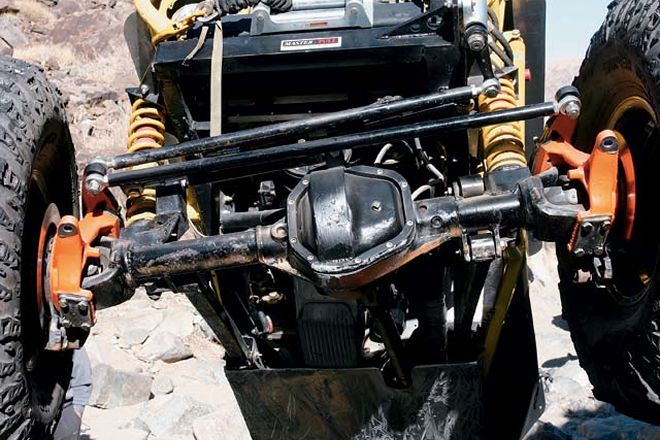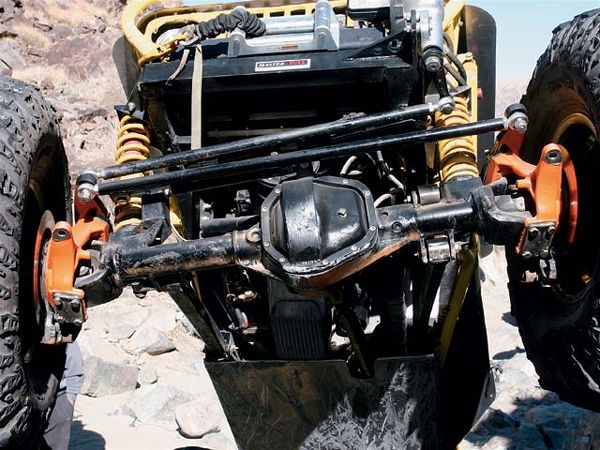
 Strutting its newfound strength on a trail in the Hammers, this old Dana 60 may just outlive the old Jeep and Jeeper atop it.
Strutting its newfound strength on a trail in the Hammers, this old Dana 60 may just outlive the old Jeep and Jeeper atop it.
I recall my first axle upgrade for the "Killer Bee," my Jeep/rock buggy I've been recreating for more than 31 years now. About 15 years ago, I got tired of rebuilding the Willys Dana 25 front axle every other week and replaced it with a cut-down Scout Dana 44. Man, that thing seemed huge under that little Flatfender. I thought I'd created a monster! Fast forward about 10 years, and I was rolling a (narrowed) Ford Dana 60 under the Jeep, replacing a Chevy 3/4-ton Dana 44 that had replaced the Scout.
Now here we are in 2006 and I'm breaking OE 1-ton Dana 60 parts. When will this carnage end? Perhaps soon, thanks to new products brought about by the demands of competitive rock racing. Racing improves the breed, the old saying goes, and in the last five years the aftermarket has just bloomed with high-tech, super-strong axle parts. These are the kind of parts us old guys used to dream about as we cut, ground, and welded old, 1-ton farm-truck junk together in hopes of creating an indestructible 4x4. After my last run to Moab, I found a large crack forming in the righthand steering knuckle on my kingpin-style Dana 60. This axle was sourced from a well worn '79 F-350. It has served me well over the last several years turning 38- to 40-inch-tall tires over trails the likes of Jackhammer, Upper Helldorado, and Die Trying. So now what? In the old days, it meant starting to think about Rockwells ... but not these days. With companies like Reid Racing (formerly Dedenbear), CTM, and Alloy USA making awesome upgrades for Dana axles, incredible strength--never dreamed of with OE pieces--is now possible.
I turned to Reid Racing to address my weak knuckle problem. For 25 years, Reid Racing (Dedenbear) has been well known in the drag racing world for its "Reaction Time Delay" boxes, along with other assorted black-box wizardry that makes no sense to us dirt guys. What does make sense are the company's bright orange, heavy-duty nodular-iron steering knuckles and inner Cs for Dana 60 front axles. I'm not sure why a drag racing company decided to make heavy-duty 60 steering parts--other than they saw the need, but I'm sure glad they did. I sure wish those weld-on Cs were around back when I narrowed my 60. They would have saved a lot of work grinding off the old OE C, only to weld it back on again to the shortened tube. Since I'm too late to benefit from the Cs, I only utilized the HD knuckles. Take a look at the photos and captions to see how these orange babies are far superior to the OE pieces.
Ever since I built it, my Dana 60 has been running the same set of OE 35-spline, 1 1/2-inch-diameter Spicer axleshafts and Spicer 5-332X U-Joints. The lefthand (short) axle was the stock length, but the righthand (long) side had been cut down and resplined. The outer stubs were upgraded to Chevy 35-splines also. I never had a failure, but every time I put those 40-inch IROKS against a wall and nudged the skinny pedal, I held my breath, waiting for that familiar sound. Upon disassembly to install the Reid Racing knuckles, I found that I wouldn't have had to hold my breath much longer. The cut-down respline was twisting, and a few more walls and--pop! It was time to upgrade the axles as well. The 4340 chromoly axleshafts are all the buzz these days and have pretty much become the norm for custom-length applications. Only the mega-bucks unobtanium 300M axles used by the top rock racers are stronger. The 4340 chromoly 'shafts offer up to 35 percent greater strength than OE units. For the recreational wheeler with Dana 60s, this kind of strength should mean years of trouble-free axle life. I went to Alloy USA for my trouble-free axles. Alloy can provide 4340 chromoly inner and outer 'shafts in stock or custom lengths. These axles feature extra material in the critical U-joint yoke area and dual heat-treating of the entire axle. The yokes are machined for full-circle U-joint retaining clips as well.
Like with most upgrades, one thing lends itself to another. Having chromoly axleshafts just screams for upgraded U-joints as well. Why have extra-strong axles and weak OE U-joints? To complement my alloy axles, I joined them together with CTM U-joints. CTM and the word "indestructible" are synonymous. CTM U-joints were the first heavy-duty axle U-joints and they have a proven track record with most of the top teams in professional rock racing. These things don't break, and it would be foolish to run chromoly axles without them. On the flip side, they should not be used with stock axles as they are made from such a stronger material, they could cause premature failure of the OE axleshaft. Check out the photos of how these U-joints are installed. So the recreating of this old Willys continues on. Who knows what it will "bee" in another 30 years? I know one thing--these Reid Racing/Alloy/CTM upgrades will probably still be hauling it over the next rock pile.








